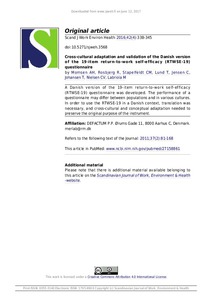Cross-cultural adaptation and validation of the Danish version of the 19-item return-to-work self-efficacy (RTWSE-19) questionnaire

Momsen, Anne-Mette H. ; Rosbjerg, Rikke ; Malmose Stapelfeldt, Christina ; Lund, Thomas ; Jensen, Chris ; Johansen, Thomas ; Nielsen, Claus V. ; Labriola, Merete
Scandinavian Journal of Work, Environment and Health
2016
42
4
338-345
occupational health survey ; questionnaire survey ; return to work
Labour market
http://dx.doi.org/10.5271/sjweh.3568
English
Bibliogr.
"Objectives
The aim of this study was to perform a cross-cultural adaptation of the return-to-work self-efficacy (RTWSE-19) scale into Danish and test the reliability, validity and responsiveness of the final version.
Methods
The adaptation process followed standard guidelines and the pretest was performed on 40 sickness absence beneficiaries. Tests of reliability, validity and responsiveness of the final version was performed on 782 participants of whom 440 (56%) responded. For the sub- and global scales, internal consistency was evaluated by Cronbach's alpha and reproducibility using paired t-test and intraclass correlation coefficient (ICC), respectively Responsiveness was evaluated by paired t-test and the association between RTWSE-19 and job status at ten weeks was tested in a logistic regression model, adjusted for gender, age and baseline job status.
Results
The face validity and reliability of the Danish version of the RTWSE-19 questionnaire were satisfactory. The internal consistency (alpha) for the three subscales ranged from 0.93 to 0.97. A test-retest showed no difference as well as high ICC between scale scores at baseline and one week later. The content validity of the final version was confirmed. High baseline RTWSE-19 level was associated with being at work after ten weeks odds ratio (OR) 3.24, 95% confidence interval (95% CI) 1.48–7.07.
Conclusions
The RTWSE-19 cross-cultural translation to Danish was performed satisfactorily. A modified final version was produced, and the test of the instrument's reliability and validity showed that the psychometric properties of the questionnaire were partly confirmed. The instrument may be useful in rehabilitation practice to guide further assessment, goal setting and RTW decision-making."
Digital
The ETUI is co-funded by the European Union. Views and opinions expressed are however those of the author(s) only and do not necessarily reflect those of the European Union or the ETUI.